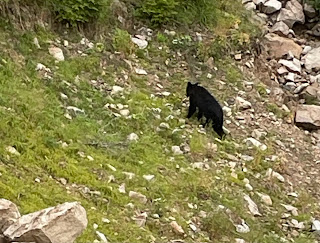After a long but enjoyable flight from Dublin to Seattle, we checked into our hotel for an overnight stay. Then following breakfast we headed back to the airport for our flight to Juneau,
We landed in Juneau and headed to our hotel. It felt as if winter had arrived early. It was overcast, cool and damp. We then remembered that we were now in a temperate rain forest. We walked downtown which did not take too long. Juneau is the state capital but it is very small with a population of just over 30,000 people.
The following morning we explored the city and visited the City museum and the State Capitol building.
In the afternoon we went whale watching and we were fortunate to see a number of humpback whales swimming quite close to us.
On the Thursday we woke up to torrential rain and boy, were we glad to have rain gear with us! We went out to the Mendenhall Valley to see the glacier which is gradually receding due to global warming. Luckily the rain eased up for a time, so it was a pleasant walk to the nearby Nugget Falls and the glacier.
On Friday morning we were up bright and early to get the ferry up to Skagway. It was a 7 hour trip with a short stop at Haines on the way. The scenery was beautiful even if some of the mountains were covered in low cloud for some of the journey.
The town has a backdrop of majestic mountains, some of which are covered in snow.
Skagway was a gold rush town infamous for its lawlessness. It had a population of 20,000 at the height of the Klondike Gold Rush but it now has a year-round population of around 1,000. The streets of downtown Skagway are lined with wooden boardwalks and restored buildings, looking much as they did 100 years ago. Skagway’s economy depends on the cruise ships which bring up to 6,000 visitors a day. The tourist season was coming to an end when we were there and it was difficult to find places to even have breakfast. Restaurants just opened and closed whenever they wanted to. They didn’t bother to keep to the opening times listed on the premises. There is only one supermarket in the town which gets deliveries on a Tuesday so the shelves are pretty empty by the weekends. That’s what life in Skagway is like!!
On May 28th, 1898 construction began on the White Pass & Yukon Route railroad and workers reached the Summit of White Pass 9 months later. Every railroad has its own colourful beginnings and for the White Pass & Yukon Route it was gold, discovered in 1896 in the Klondike.
The White Pass & Yukon Route climbs from sea level in Skagway to almost 3,000 feet at the summit in just 20 miles and features some very steep grades. Along the journey which we took on Saturday, we saw breathtaking views of soaring glacier-cloaked peaks, countless waterfalls and pristine alpine lakes.
However the weather conditions changed on the return journey due to very low clouds and rain. At one place the train had to stop to allow a black bear on his way.
On the Sunday we went to Eagles Hall the local theatre to see the popular Days of ‘98 Show, Alaska’s longest running theatre production. The show dates back to 1923.
We stayed in At the White House, which was built in 1902 and used by the Army as a hospital during World WarTwo. The house still had a number of original features including a beautiful old wooden staircase.
On Monday we took the ferry to return to Juneau for an overnight stay before flying back to Seattle on Tuesday.


























Hello T&S.,
ReplyDeleteToday was the first time I looked up your blog and discovered that you have been to Alaska and back! Great photos, hard to believe that we are talking about the U.S.A. it all looks so very different from anywhere else but it also looks beautiful and fascinating. Up close with a brown bear, even if from the safety of a train, must count as a bit of an adventure! Enjoy all, stay well and take care! Rosaleen
Hi Therese and Sylvia, you have had a great week in Alaska, I have enjoyed reading your blog, a very good commentary with great photos, I feel that I have learnt something about Alaska. Enjoy the next stage of the adventure, I look forward to the next episode of the blog. Safe driving . Mary
ReplyDeleteBeautiful scenery. Alaska must be incredible. The size of the EU with a population hardly bigger than Dublin City. Very impressive ferry which I assume you travelled on. By the way why is there a Mountie outpost in a US state ?
ReplyDeleteThe Mountie outpost is there because the train goes into British Columbia for a short distance in order to turn and continue its journey back to Skagway.
DeleteI hope they had wine in Skagway!! Sounds like a great start to your amazing trip. Looking forward to following it.
ReplyDeleteAs you know, I grew up in the States but for me Alaska was always a ‘far away land’. Your commentary and pictures give such wonderful intimate picture that I feel I’m almost there with you. Can hardly wait for your next post. Margaret
ReplyDelete